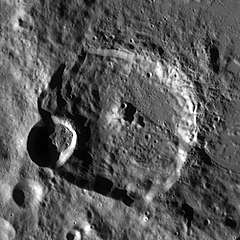Slipher (lunar crater)
Slipher is a lunar impact crater, that is located in the northern latitudes on the far side of the Moon. The crater overlies the southwestern outer rim of the much larger walled plain D'Alembert, and it occupies a portion of the interior floor of D'Alembert. To the south-southeast is the crater Langevin.
 LRO image | |
| Coordinates | 49.5°N 160.1°E |
|---|---|
| Diameter | 69 km |
| Depth | Unknown |
| Colongitude | 200° at sunrise |
| Eponym | Earl Slipher Vesto Slipher |
Because it overlies D'Alembert, Slipher is a younger formation and it has undergone much less erosion. The rim is circular but has a somewhat irregular edge. The rim is jumbled and irregular where it intersects D'Alembert. Overlapping the western rim and inner walls of Slipher is the smaller Slipher S, a fresh feature with a sharp-edged outer rim. The interior floor of Slipher is somewhat uneven except in the northeast, and there is a cluster of low central ridges near the midpoint.
Satellite craters
By convention these features are identified on lunar maps by placing the letter on the side of the crater midpoint that is closest to Slipher.
| Slipher | Latitude | Longitude | Diameter |
|---|---|---|---|
| S | 49.2° N | 158.7° E | 26 km |
See also
- 1766 Slipher, main-belt asteroid
References
- Andersson, L. E.; Whitaker, E. A. (1982). NASA Catalogue of Lunar Nomenclature. NASA RP-1097.CS1 maint: ref=harv (link)
- Blue, Jennifer (July 25, 2007). "Gazetteer of Planetary Nomenclature". USGS. Retrieved 2007-08-05.CS1 maint: ref=harv (link)
- Bussey, B.; Spudis, P. (2004). The Clementine Atlas of the Moon. New York: Cambridge University Press. ISBN 978-0-521-81528-4.CS1 maint: ref=harv (link)
- Cocks, Elijah E.; Cocks, Josiah C. (1995). Who's Who on the Moon: A Biographical Dictionary of Lunar Nomenclature. Tudor Publishers. ISBN 978-0-936389-27-1.CS1 maint: ref=harv (link)
- McDowell, Jonathan (July 15, 2007). "Lunar Nomenclature". Jonathan's Space Report. Retrieved 2007-10-24.CS1 maint: ref=harv (link)
- Menzel, D. H.; Minnaert, M.; Levin, B.; Dollfus, A.; Bell, B. (1971). "Report on Lunar Nomenclature by the Working Group of Commission 17 of the IAU". Space Science Reviews. 12 (2): 136–186. Bibcode:1971SSRv...12..136M. doi:10.1007/BF00171763.CS1 maint: ref=harv (link)
- Moore, Patrick (2001). On the Moon. Sterling Publishing Co. ISBN 978-0-304-35469-6.CS1 maint: ref=harv (link)
- Price, Fred W. (1988). The Moon Observer's Handbook. Cambridge University Press. ISBN 978-0-521-33500-3.CS1 maint: ref=harv (link)
- Rükl, Antonín (1990). Atlas of the Moon. Kalmbach Books. ISBN 978-0-913135-17-4.CS1 maint: ref=harv (link)
- Webb, Rev. T. W. (1962). Celestial Objects for Common Telescopes (6th revised ed.). Dover. ISBN 978-0-486-20917-3.CS1 maint: ref=harv (link)
- Whitaker, Ewen A. (1999). Mapping and Naming the Moon. Cambridge University Press. ISBN 978-0-521-62248-6.CS1 maint: ref=harv (link)
- Wlasuk, Peter T. (2000). Observing the Moon. Springer. ISBN 978-1-85233-193-1.CS1 maint: ref=harv (link)